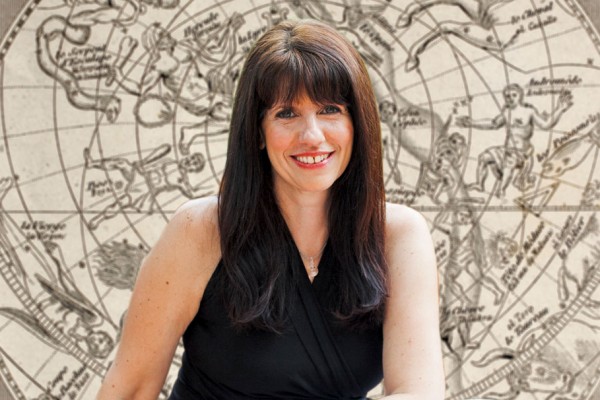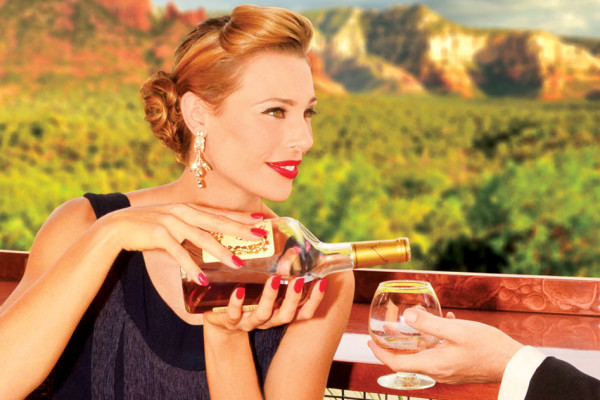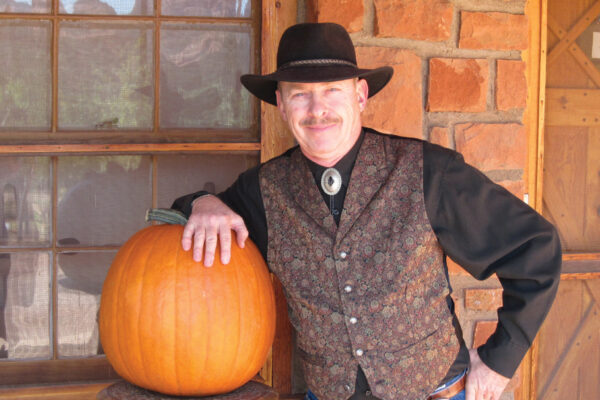Continued (page 2 of 2)
Octavius and Irma Seowtewa: Silversmiths
Jewelers Octavius and Irma Seowtewa used to work side by side in a room in their home at the Zuni Pueblo until one day Octavius struggled more than usual with a 14-karat gold piece of jewelry. “Octavius was frustrated, and he used some undesirable language,” says Irma, laughing. “I suggested he work in one room, and I work in another room, so that’s how it is today.”
Octavius and Irma collaborate on all of their needlepoint necklaces, bolo ties, bracelets, rings and earrings. (Octavius also works solo on nugget pieces and commissions such as a recently finished watch bracelet depicting a train engine and caboose for a train conductor.) He creates the sterling-silver settings while Irma cuts and sets the stones (they use only natural stones – nothing stabilized or synthetic).
Irma says she learned the art of needlepoint jewelry from her mom, aunt and uncle, while Octavius picked it up from his mom, Odelle Seowtewa, who was a well-respected petit point jewelry artist. His father, Alex Seowtewa, is a household name among Zuni art aficionados; Alex’s paintings can be found inside the mission at the Zuni Pueblo, and he even traveled to the Kremlin in Moscow to lecture about his paintings. Octavius has been making jewelry for 40 years while Irma has been doing it for 35. The two are known for their swirl designs, which Octavius came up with while watching children play with a pinwheel. Zuni needlepoint and petit point designs are some of the most intricate Native American jewelry on the market – the style dates back to the 1920s. (How can you tell the difference between needlepoint and petit point? Needlepoint stones are pointed on both ends while petit point stones are shaped like pears or teardrops.) To listen to Octavius and Irma describe how a piece is created makes you shake your head in awe. It’s no wonder many younger Zunis, including Octavius and Irma’s son, don’t have the patience for the craft.
Octavius comes up with a design and makes a list of stones Irma will need. While he’s using his extensive collection of tools to create the silverwork, Irma is cutting and grinding stones into cabochons. Irma says she usually cuts as many as 100 extra cabochons because she doesn’t know which ones will match or which tiny slivers of turquoise, coral, shell or black marble will crack during the process. Using jewelers wax and a candle flame, she attaches each stone to the end of a toothpick and completes the final grinding process with a lapidary wheel. She mounts the stones in Octavius’ silver bezel cups using glue and then crimps the cups shut with tweezers. The duo can’t solder silver or mount stones with the air conditioning running because the blowing air affects the flames, so at this time of the year, they are working in extremely harsh conditions. “It’s very tedious,” says Irma.
Still, Octavius says the couple has it easier than their mothers, who didn’t have the luxury of going to the store and buying toothpicks for their jewelry. “Our moms and uncles used willow sticks that they would collect and shave to the size they wanted,” he says.
Octavius and Irma sell their work directly to galleries across the globe, including a new location in Tokyo, and they travel for shows. Most years, you can find them at the Zuni Festival of Arts and Culture at the Museum of Northern Arizona and at the Heard Museum’s Indian Fair and Art Market. They occasionally sell their work to traders who come through the pueblo, though Octavius admits it’s more profitable to sell direct to galleries and museum shops. But the couple has such busy schedules nowadays that they aren’t producing the amount of jewelry that they used to. Octavius is a Zuni medicine man, so he’s frequently in demand in his community. And since the early 1990s, he’s worked as a cultural consultant for the tribe, traveling to museums all over the world to identify Zuni artifacts and educate people as to their uses. “I’ve been to museums in New York, LA, London, Berkeley – I might be going to Amsterdam this year, too,” he says. “I try to set the record straight because sometimes the info these museums have is really off the wall. I have to chuckle – it can be very esoteric. When I return, I have to write a report for Zuni about what I’ve found. It’s a lot of work, but it’s important that everyone has accurate info.”
Octavius has also traveled down the Colorado River through the Grand Canyon 15 times, working with the National Park Service to monitor Zuni archaeological sites and various springs that have been significant to the tribe. Irma laughs when asked if she gets to go along. “I wish,” she says. “I run the house. I call myself a domestic engineer.”
Octavius and Irma’s daughter-in-law, Connie Seowtewa, also creates needlepoint jewelry, and Irma says her granddaughter has expressed an interest in learning, but the Seowtewas are adamant that she finish college first. Still, Octavius maintains that needlepoint and petit point are dying art forms. “It’s the type of work Zuni are known for, and I wish the younger generation would pick up on it,” he says.
It’s obvious that Octavius and Irma still love jewelry making, even if it is tedious work. Octavius says he likes to be his own boss and set his own schedule, though sometimes that means working until 2 a.m. He also likes the creativity. “I’m not working for someone who’s demanding 100 chokers of the same style,” he says.
Irma, however, confesses she’s sentimental about her trade. “It means a lot to me to continue the tradition,” she says. “I’m using some of the same tools as my family did, and that’s special.”
MORE NATIVE AMERICAN ARTISTS: Navajo silversmiths, Hopi katsina carvers, Acoma potters, Navajo weavers, Hopi potters, jewelers and basket makers, Navajo sandpainters



